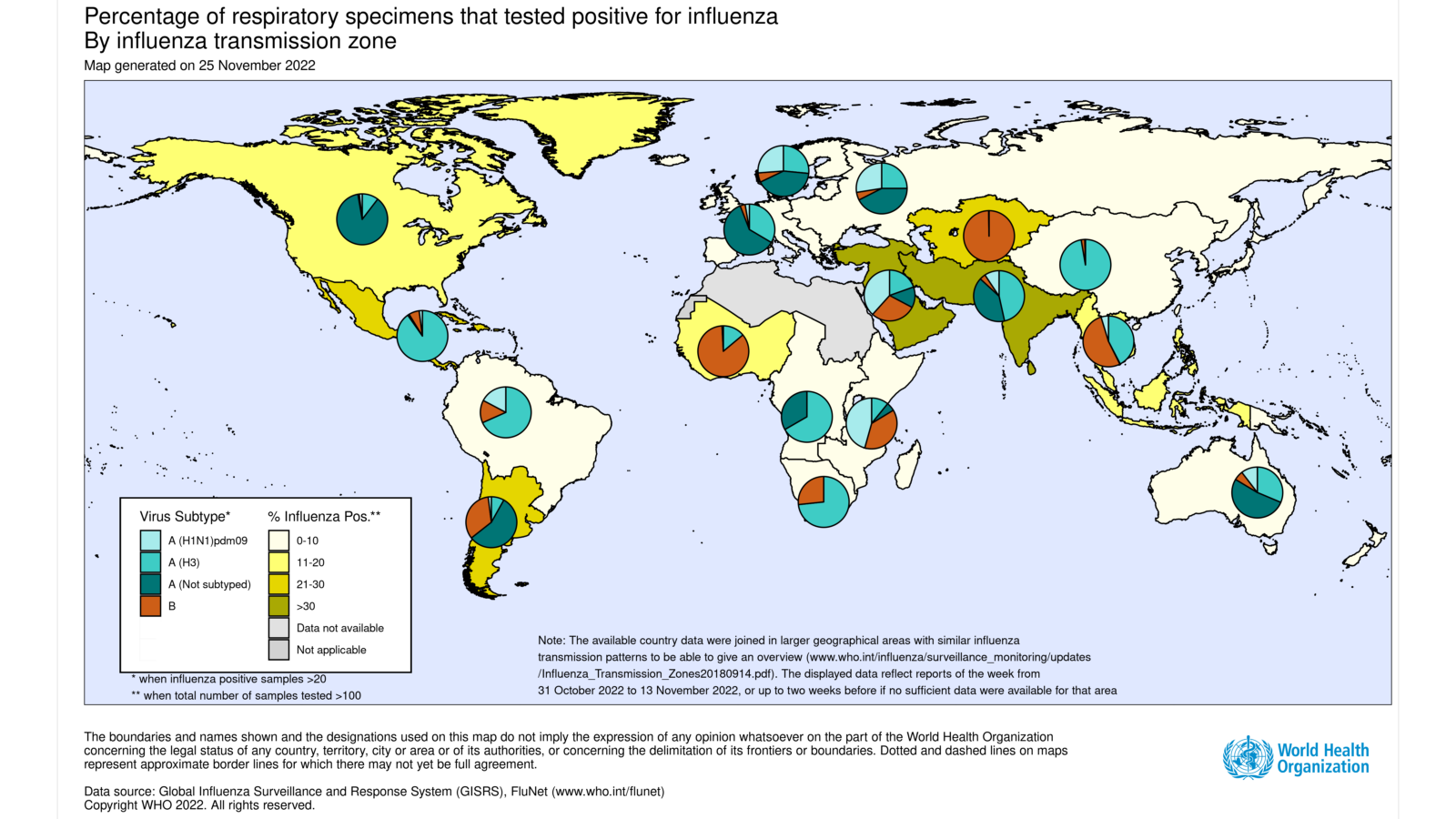Influenza Update N° 433

Overview
28 November 2022, based on data up to 13 November 2022
Information in this report is categorized by influenza transmission zones, which are geographical groups of countries, areas or territories with similar influenza transmission patterns. For more information on influenza transmission zones, see the link below:
Influenza Transmission Zones (pdf, 659kb)
- Countries are recommended to monitor the co-circulation of influenza and SARS-CoV-2 viruses. They are encouraged to enhance integrated surveillance and in northern hemisphere countries step-up their influenza vaccination campaign to prevent severe disease and hospitalizations associated with influenza. Clinicians should consider influenza in differential diagnosis, especially for high-risk groups for influenza, and test and treat according to national guidance.
- Globally, influenza activity increased and where subtyped, influenza A(H3N2) viruses predominated.
- In the countries of North America, influenza positivity and influenza-like-illness (ILI) activity increased steeply in recent weeks, indicating an earlier start of the influenza season in comparison with pre-COVID-19-pandemic seasons. Influenza A(H3N2) was the predominant virus detected.
- In Europe, overall influenza activity continued to increase with influenza positivity reported above epidemic threshold in some countries. Influenza A viruses predominated among the reported detections in general, with A(H3N2) viruses accounting for the majority of subtyped influenza A viruses.
- In central Asia, Kazakhstan reported high influenza activity with B/Victoria-lineage viruses predominating.
- In East Asia, influenza activity of predominantly influenza A(H3N2) remained stable at intermediate levels overall.
- In Western Asia influenza activity remained elevated, especially in some countries of the Arabian Peninsula.
- In the Caribbean and Central American countries, influenza activity of predominately influenza A(H3N2) increased in Mexico but remained low in most other reporting countries.
- In the tropical countries of South America, influenza detections were low and A(H3N2) detections predominated.
- In tropical Africa, influenza activity remained low with detections of influenza A(H1N1)pdm09, A(H3N2) and B/Victoria reported.
- In Southern Asia, influenza activity increased steeply mainly due to elevated activity reported in Iran (Islamic Republic of). Influenza A(H3N2) was the most frequently detected subtype in the subregion.
- In South East Asia, detections of predominantly influenza A(H3N2) and influenza B continued to decrease.
- In the temperate zones of the southern hemisphere, influenza activity continued to decrease in most reporting countries, except in temperate South America where activity increased in Argentina and Chile.
- National Influenza Centres (NICs) and other national influenza laboratories from 125 countries, areas or territories reported data to FluNet for the time period from 31 October 2022 to 13 November 2022* (data as of 2022-11-29 05:35:56 UTC). The WHO GISRS laboratories tested more than 465 365 specimens during that time period. 56 551 were positive for influenza viruses, of which 53 829 (95.2%) were typed as influenza A and 2 722 (4.8%) as influenza B. Of the sub-typed influenza A viruses, 2 024 (16.3%) were influenza A(H1N1)pdm09 and 10 356 (83.7%) were influenza A(H3N2). Of the characterized B viruses (550), 100% belonged to the B-Victoria lineage.

- COVID-19 positivity from sentinel surveillance slightly increased but remained under 10%, after a long-term downtrend beginning in mid-2022. Activity appeared to increase in the African Region, Eastern Mediterranean Region and Region of the Americas, with percent positivity remaining below 10%. In the European and South-East Asia Region, positivity was stable slightly above 10%. In the Western Pacific Region, positivity declined below 10%. Globally, COVID-19 positivity from non-sentinel surveillance increased in recent weeks and was around 10%.
- During the COVID-19 pandemic, WHO encourages countries, especially those that have received the multiplex influenza and SARS-CoV-2 reagent kits from GISRS, to conduct integrated surveillance of influenza and SARS-CoV-2 and report epidemiological and laboratory information in a timely manner to established regional and global platforms. Revised interim guidance has just been published here: https://covid.comesa.int/publications/i/item/WHO-2019-nCoV-integrated_sentinel_surveillance-2022.1.
- National Influenza Centres (NICs) and other national influenza laboratories from 63 countries, areas or territories from six WHO regions (African Region: 9; Region of the Americas: 17; Eastern Mediterranean Region: 4; European Region: 24; South-East Asia Region: 4; Western Pacific Region: 5) reported to FluNet from sentinel surveillance sites for the time period from 31 October 2022 to 13 November 2022* (data as of 2022-11-25 08:22:37 UTC). The WHO GISRS laboratories tested more than 41 704 sentinel specimens during that time period and 2 970 (7.1%) were positive for SARS-CoV-2. Additionally, more than 156 762 non-sentinel or undefined reporting source samples were tested in the same period and 13 620 were positive for SARS-CoV-2. Further details are included at the end of this update.
Source of data
______________________________________________________________________________________________
The Global Influenza Programme monitors influenza activity worldwide and publishes an update every two weeks. The updates are based on available epidemiological and virological data sources, including FluNet (reported by the WHO Global Influenza Surveillance and Response System), FluID (epidemiological data reported by national focal points) and influenza reports from WHO Regional Offices and Member States. Completeness can vary among updates due to availability and quality of data available at the time when the update is developed.
*It includes data only from countries reporting on positive and negative influenza specimens.
